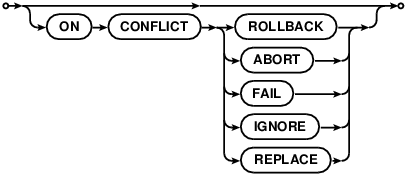
Choose any three.
|
|
SQLite里的SQL
SQL As Understood By SQLite
ON CONFLICT clause
ON CONFLICT子句不是一个独立的SQL命令。这是一个非标准的子句,可以用在许多其他SQL命令中。之所以为其单独划分一章是因为它不是标准SQL的一部分,因此与其他命令联系并不紧密。
The ON CONFLICT clause is not a separate SQL command. It is a
non-standard clause that can appear in many other SQL commands.
It is given its own section in this document because it is not
part of standard SQL and therefore might not be familiar.
上图所示的是ON CONFLICT子句在CREATE TABLE命令中的语法。在INSERT和UPDATE命令中需要使用关键词"OR"替换"ON CONFLICT"以便该语法阅读更加自然。例如,使用 "INSERT OR IGNORE"替代"INSERT ON CONFLICT IGNORE"。虽然关键词变了,但是这个子句的含义是一样的。
The syntax for the ON CONFLICT clause is as shown above for
the CREATE TABLE command. For the INSERT and
UPDATE commands, the keywords "ON CONFLICT" are replaced by "OR" so that
the syntax reads more naturally. For example, instead of
"INSERT ON CONFLICT IGNORE" we have "INSERT OR IGNORE".
The keywords change but the meaning of the clause is the same
either way.
ON CONFLICT子句适用于UNIQUE和NOT NULL约束(还包括PRIMARY KEY约束这种与UNIQUE约束类似的约束)。ON CONFLICT算法不用应用于FOREIGN KEY 约束。一共有五个可选的冲突解决算法:ROLLBACK、ABORT、FAIL、IGNORE和REPLACE。默认的冲突解决算法是ABORT。下面是这些算法的具体含义:
The ON CONFLICT clause applies to UNIQUE and NOT NULL
constraints (and to PRIMARY KEY constraints which for the purposes
of this section are the same thing as UNIQUE constraints).
The ON CONFLICT algorithm does not
apply to FOREIGN KEY constraints.
There are five conflict resolution algorithm choices:
ROLLBACK, ABORT, FAIL, IGNORE, and REPLACE.
The default conflict resolution algorithm is ABORT. This
is what they mean:
- ROLLBACK
当发生支持的约束违规时,ROLLBACK解决算法会终止当前的SQL语句,抛出一个SQL_CONSTRAINT错误,并回滚当前事务。如果当前没有有效的事务(不包括隐式事务,隐式事务会在每个命令开始前创建)那么ROLLBACK解决算法的处理方案会喝ABORT算法一样。
When an applicable constraint violation occurs, the ROLLBACK resolution algorithm aborts the current SQL statement with an SQLITE_CONSTRAINT error and rolls back the current transaction. If no transaction is active (other than the implied transaction that is created on every command) then the ROLLBACK resolution algorithm works the same as the ABORT algorithm.- ABORT
当发生支持的约束违规时,ABORT解决算法会终止当前SQL语句,抛出一个SQLITE_CONSTRAINT错误并撤销当前SQL语句做出的所有修改。但是同一个事务中之前的SQL语句做出的修改会被保留并且事务会恢复执行。这是默认的行为,也是SQL标准中规定的行为。
When an applicable constraint violation occurs, the ABORT resolution algorithm aborts the current SQL statement with an SQLITE_CONSTRAINT error and backs out any changes made by the current SQL statement; but changes caused by prior SQL statements within the same transaction are preserved and the transaction remains active. This is the default behavior and the behavior specified by the SQL standard.- FAIL
当发生支持的约束违规时,FAIL冲突解决算法会终止当前SQL语句,抛出一个SQLITE_CONSTRAINT错误。不过FAIL解决方法不会撤销这个SQL语句已经做出的修改,而且这条语句的失败并不会导致当前事务结束。 例如:当一个UPDATE进行更新时,第100行违反了约束规则,那么前99行修改都会被保留,而对第100行的修改则不会发生。
When an applicable constraint violation occurs, the FAIL resolution algorithm aborts the current SQL statement with an SQLITE_CONSTRAINT error. But the FAIL resolution does not back out prior changes of the SQL statement that failed nor does it end the transaction. For example, if an UPDATE statement encountered a constraint violation on the 100th row that it attempts to update, then the first 99 row changes are preserved but changes to rows 100 and beyond never occur.- IGNORE
当发生支持的约束违规时,IGNORE冲突解决算法会跳过违反约束的那一行数据,就像没有错误发生一样继续处理SQL语句中后续的行。在违反约束那行数据前后的插入或更新都可以正常执行。当使用IGNORE冲突解决算法是不会返回任何错误。
When an applicable constraint violation occurs, the IGNORE resolution algorithm skips the one row that contains the constraint violation and continues processing subsequent rows of the SQL statement as if nothing went wrong. Other rows before and after the row that contained the constraint violation are inserted or updated normally. No error is returned when the IGNORE conflict resolution algorithm is used.- REPLACE
当一个UNIQUE约束被违反时,REPLACE算法会删除导致约束违规的那个已经存在的行,然后插入或更新当前行,整个命令会正常的继续执行。 如果是违反了NOT NULL约束,REPLACE冲突解决算法会使用这一列的默认值来替代NULL值,如果当前列没有默认值,那么会使用ABORT算法。 如果是违反了CHECK约束,REPLACE冲突解决算法的处理方式会与ABORT一样。
When a UNIQUE constraint violation occurs, the REPLACE algorithm deletes pre-existing rows that are causing the constraint violation prior to inserting or updating the current row and the command continues executing normally. If a NOT NULL constraint violation occurs, the REPLACE conflict resolution replaces the NULL value with the default value for that column, or if the column has no default value, then the ABORT algorithm is used. If a CHECK constraint violation occurs, the REPLACE conflict resolution algorithm always works like ABORT.当REPLACE冲突解决策略为了满足约束而删除记录时,只有当开启了递归触发器才会执行删除触发器。
When the REPLACE conflict resolution strategy deletes rows in order to satisfy a constraint, delete triggers fire if and only if recursive triggers are enabled.由REPLACE冲突解决策略删除的记录是不会执行update hook的。REPLACE也不会增加修改计数器。不过这段记录的这些特殊行为在未来的版本中可能会做出修改。
The update hook is not invoked for rows that are deleted by the REPLACE conflict resolution strategy. Nor does REPLACE increment the change counter. The exceptional behaviors defined in this paragraph might change in a future release.
在INSERT或UPDATE语句中使用OR子句指定的算法会覆盖CREATE TABLE中指定的算法。如果两处都没有指定算法,那么会使用ABORT算法。
The algorithm specified in the OR clause of an INSERT or UPDATE
overrides any algorithm specified in a CREATE TABLE.
If no algorithm is specified anywhere, the ABORT algorithm is used.
